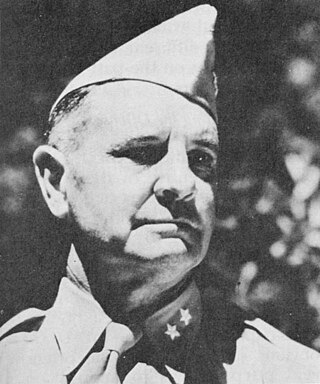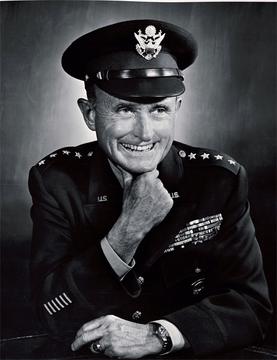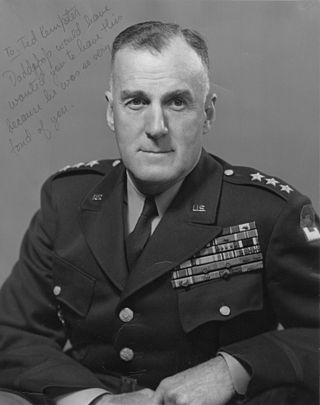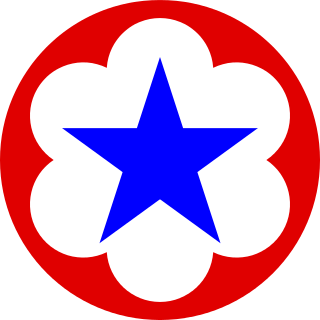
Omar Nelson Bradley was a senior officer of the United States Army during and after World War II, rising to the rank of General of the Army. He was the first chairman of the Joint Chiefs of Staff and oversaw the U.S. military's policy-making in the Korean War.

Geoffrey Keyes was a highly decorated senior United States Army officer who served with distinction in Sicily and Italy during World War II.

The Walter Reed Army Medical Center (WRAMC), officially known as Walter Reed General Hospital (WRGH) until 1951, was the U.S. Army's flagship medical center from 1909 to 2011. Located on 113 acres (46 ha) in Washington, D.C., it served more than 150,000 active and retired personnel from all branches of the United States Armed Forces. The center was named after Walter Reed, a U.S. Army physician and sergeant who led the team that confirmed that yellow fever is transmitted by mosquitoes rather than direct physical contact.

Jacob Loucks Devers was a general in the United States Army who commanded the 6th Army Group in the European Theater of World War II. He was involved in the development and adoption of numerous weapons, including the M4 Sherman and M26 Pershing tanks, the DUKW amphibious truck, the Bell H-13 Sioux helicopter, and the M16 rifle.

General Joseph Lawton Collins was a senior United States Army officer. During World War II, he served in both the Pacific and European Theaters of Operations, one of a few senior American commanders to do so. He was Chief of Staff of the United States Army during the Korean War.

Lieutenant General Frank Maxwell Andrews was a senior officer of the United States Army and one of the founders of the United States Army Air Forces, which was later to become the United States Air Force. In leadership positions within the Army Air Corps, he succeeded in advancing progress toward a separate and independent Air Force where predecessors and allies such as Billy Mitchell had failed. Andrews was the first head of a centralized American air force and the first air officer to serve on the Army's general staff. In early 1943, he took the place of General Dwight D. Eisenhower as commander of all U.S. troops in the European Theater of Operations.

General Alfred Maximilian Gruenther was a senior United States Army officer, Red Cross president, and bridge player. After being commissioned towards the end of World War I, he served in the army throughout the interwar period and into World War II, where he was primarily a staff officer. Several years later, at the age of fifty-two, he became the second youngest four-star general in the history of the United States Army, after only Douglas MacArthur, and succeeded General Matthew Ridgway as NATO's Supreme Allied Commander in Europe (SACEUR) serving from 1953 to 1956.

Leonard Townsend Gerow was a general in the United States Army who served with distinction in both World War I and World War II.

Lieutenant General Edward Hale Brooks was a highly decorated senior officer of the United States Army, a veteran of both World War I and World War II, who commanded the U.S. Second Army during the Korean War. He received the Distinguished Service Cross (DSC) for heroism as a junior officer in World War I and, remaining in the army during the interwar period, rose to command the 2nd Armored Division during the Battle of Normandy as well as VI Corps during the subsequent defeat of German forces in World War II.

"The class the stars fell on" is an expression used to describe the class of 1915 at the United States Military Academy in West Point, New York. In the United States Army, the insignia reserved for generals is one or more stars. Of the 164 graduates that year, 59 (36%) attained the rank of general, more than any other class in the history of the academy, hence the expression.

The Army Service Forces was one of the three autonomous components of the United States Army during World War II, the others being the Army Air Forces and Army Ground Forces, created on 9 March 1942. By dividing the Army into three large commands, the Chief of Staff, General George C. Marshall, drastically reduced the number of officers and agencies reporting directly to him. The Army Service Forces brought together elements of five different components of the Army: elements of the War Department General Staff (WDGS), especially its G-4 division ; the Office of the Under Secretary of War; the eight administrative bureaus; the nine corps areas, which became service commands; and the six supply arms and services, which became known as the technical services. The Army Service Forces was initially known as the United States Army Services of Supply but the name was changed on 12 March 1943, as it was felt that the term "supply" did not accurately describe the broad range of its activities. The Army Service Forces was abolished on 11 June 1946 and most of its functions were taken over by the War Department General Staff.

General Sir William Godfrey Fothergill Jackson, was a British Army officer, military historian, author and Governor of Gibraltar.

Lieutenant General Willis Dale Crittenberger was a senior officer of the United States Army. He was a career soldier who served with distinction during the Italian campaign of World War II
A general officer is an officer of high military rank; in the uniformed services of the United States, general officers are commissioned officers above the field officer ranks, the highest of which is colonel in the Army, Marine Corps, Air Force, and Space Force and captain in the Navy, Coast Guard, Public Health Service Commissioned Corps (PHSCC), and National Oceanic and Atmospheric Administration Commissioned Corps (NOAACC).

Major General Leland Stanford Hobbs was a decorated senior United States Army officer who commanded the 30th Infantry Division in Western Europe during World War II.

Lieutenant General Henry Spiese Aurand was a United States Army career officer. He was a veteran of World War I, World War II, and the Korean War. A graduate of the United States Military Academy at West Point, New York, Aurand was ranked 20th in the class of 1915, known as "the class the stars fell on" because no fewer than 59 of the 164 members of the class who graduated became generals. His classmates included Dwight D. Eisenhower and Omar Bradley, both of whom later achieved five-star rank. He was commissioned in the Coast Artillery Corps, but later transferred to the Ordnance Department.

Major General Ernest Joseph "Mike" Dawley was a senior officer of the United States Army, best known during World War II for commanding the VI Corps during Operation Avalanche, the Allied landings at Salerno, Italy, in 1943. After the landings, he was relieved of his command by Lieutenant General Mark W. Clark, commander of the Fifth Army, and returned to the United States.

Samuel Hof was an officer in the United States Army during World War I. He was 13th Chief of Ordnance for the U.S. Army Ordnance Corps.

Everett Strait Hughes was a major general in the United States Army and served as the 17th Chief of Ordnance for the U.S. Army Ordnance Corps. He is known for his close association with Dwight D. Eisenhower. Hughes was born in Ipswich, Dakota Territory, was a West Point graduate, and rose to become major general in the U.S. Army. He fought in a number of battles including the Mexican border war and World War I. During World War II he was one of George S. Patton's close friends and Eisenhower's "right-hand man" during the entire European campaign.

John French Conklin was an American brigadier general, who served most of his career in the United States Army Corps of Engineers. During the World War II, Conklin served as Chief Engineer, Third U.S. Army.




















